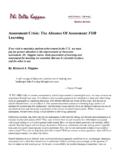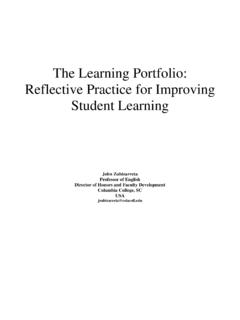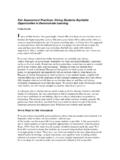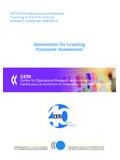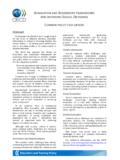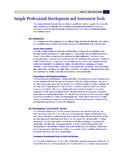Transcription of Assessment For Learning: Planning for …
1 1 Assessment For learning : Planning for professional development Anne Davies, Margaret Arbuckle, Doris Bonneau1 Assessment has the power to transform both learning and teaching because it is sointegrally linked to motivation and learning . The increased attention being paid to standardsand their Assessment has created a new opportunity to support learning and improveclassroom practices. Providing long-term, differentiated, multi-dimensional and flexibleapproaches to adult learning for all members of the school community is essential andchallenging. For many of us seizing this opportunity to support student learning requiresrethinking adult learning and using Assessment to guide our professional developmentwork.
2 In an Assessment for learning environment, rather than something that happens at theend of the learning , Assessment is used to support and inform learning , build self-confidence, and capacity for success. (Stiggins, 2001). Assessment for learning is ongoing,and requires deep involvement on the part of the learner in clarifying outcomes, monitoringon-going learning , collecting evidence and presenting evidence of learning to the difference between Assessment of learning and Assessment for learningis key.[See Figure 1 - Page 10] Assessment for learning has increasingly become the focus of research (Black & William,1998; 2003; Crooks, 1988; Sadler, 1989; Stiggins, 2001). Assessment that directly supportslearning has five key characteristics: learners are involved so a shared language and understanding of learning is developed, learners self-assess and receive specific, descriptive feedback about the learning duringthe learning , learners collect, organize, and communicate evidence of their learning with others, instruction is adjusted in response to ongoing Assessment information, and a safe learning environment invites risk taking, encourages learning from mistakes,enables focused goal setting, and supports thoughtful use Assessment for learning as the organizing core of adult learning ?
3 Experience andresearch tells us that adults (like student learners) have more ownership, are more motivated 1 Authors note: The authors would like to thank Kathy Busick for her thoughtful commentsand suggestions on earlier learn, actually learn more when we begin with the end in mind and involve learners ofall ages in the Assessment for learning process. We are using Assessment to guide adultlearning in the same way that classroom teachers are being asked to use Assessment forlearning to guide and support student learning for Student LearningIn order for adult learning to be successful, it needs to be on-going, sustained and connectedto other aspects of change in the school community (Arbuckle, 2000).
4 Adult learners are notunlike young children in their acquisition of new concepts. Adult learners also need to beengaged in their learning in a variety of ways both alone and with others. They need toknow that success has many different looks. As people involved in designing adult learningopportunities, we undermine our work when we begin to think that efficiencies can begained by doing the same thing, at the same time, in the same way ( Little, 1994;Darling-Hammond, 1997; Senge, 1990). learning needs to be encouraged and supported inmultiple learning that supports and sustains life long, independent, self-directed learners drawsupon educators' strengths, communicates self worth and capability, and views participants'individual differences as a value-added benefit to the group.
5 learning leading to action ispurposeful, grounded in work with students, and relevant to the adult learner. It isdifferentiated. Change - learning - engages learners in applying powerful ideas and practicesin practical ways, offers opportunities for reflecting upon their experiences and the impacton students, and adjusting practices as needed.( Arbuckle, 2000; Darling-Hammond &Mclaughlin, 1995; Lieberman, 1995; Lieberman and Miller, 2001).Differentiating learning Needs and StrengthsThe work of Prochaska, DiClemente, and Norcross (1994) provides a helpful frameworkfor thinking about adult learning . Their research identified the following stages as adultschange their habits and practices: precontemplation (thinking about thinking about it),contemplation (thinking about it), initiation ( Planning to do it), action (actually doing it), andmaintenance (doing it consistently).
6 To expand this framework beyond the self to others, wehave added three more stages teaming (doing it with someone else in order to sustainenergy and learning ), mentoring (helping others to do it), and leading the learning of this framework enables us to analyze the needs of adult learners and design effectivelearning To LearnersWhen we listen to adults talk, we learn about what they know and what they want to we talk with educators and listen to accounts of their current challenges, we come tobetter understand what they might need or want to know and be able to do. Listening tolearners also allows us to draw upon and respect the experiences they bring to our worktogether. They too are listening and learning .
7 This kind of listening is a key part ofassessment for learning . It allows professional learning opportunities to be designed anddifferentiated to meet emerging needs. It also models the Assessment for learning strategieswe are asking teachers to learn about and implement in their classrooms bringing our workwith educators into alignment with Assessment in classrooms. With Assessment for learningas the base, educators are being engaged in conversations that focus on looking at studentwork (Blythe et al, 1999; Langer et al, 2003); considering Assessment for learning strategieswith their students in mind (Davies, 2003); reflecting upon research, theory, and teachingpractices (Cushman, 1996; Glaude, in press; McDonald et al, 2003; Wellman & Garmston,1999) as well as examining quantitative data generated from school, district and large scaleassessments (Schmoker, 2001).
8 Consider the school and district directions you are kind of learning opportunities are needed? What are you learning as you listen to theadult learners you serve and support?Listening for Pre-Contemplation. Applying the extended framework of Prochaska,DiClemente, and Norcross (1994) to differentiate professional development begins withlistening to learners. wonders, This is nothing new. What is there to think about?"Educators like Ms. A do not see a reason to change. As we listen to learners like Ms. A werealize the challenge is to provide a context where learning is necessary and ways to spark their interest without overwhelming them is essential. Opportunitiesneed to be created to acknowledge what they already know and help them see connectionsbetween what they already do and what they need to consider given the goals they have fortheir students learning Pre-Contemplation.
9 Ms. A will be more likely to see the importance of changeand continued learning if the school and district within which she works has a clear andcoherent vision along with a long term commitment to support change. The kinds of4learning opportunities that support these educators in their learning include the articulationof clear direction, general awareness sessions to develop an understanding of the proposedchanges, resource materials that provide practical information, as well as invitations to haveconversations about what works with people they respect and from whom they are willing and Supporting Contemplation. Mr. B's point of view is characterized by,"Yes, the change is important and I'll think about it when I'm not so busy.
10 " The challengeof supporting learners who are beginning to contemplate taking action is to help educatorslike Mr. B understand that the proposed changes can make teaching and learning need to see that the change they are contemplating will support learning . For example,one change some schools and districts are undertaking is a focus on Assessment forlearning (Willis et al, 2002). There is much research and practical evidence that such acourse can directly support student learning . For many educators, moving beyondcontemplation also requires a shift in the focus of current classroom Assessment . Educatorsneed classroom and school-based Assessment ideas that are simple and effective. Educatorslike Mr.
